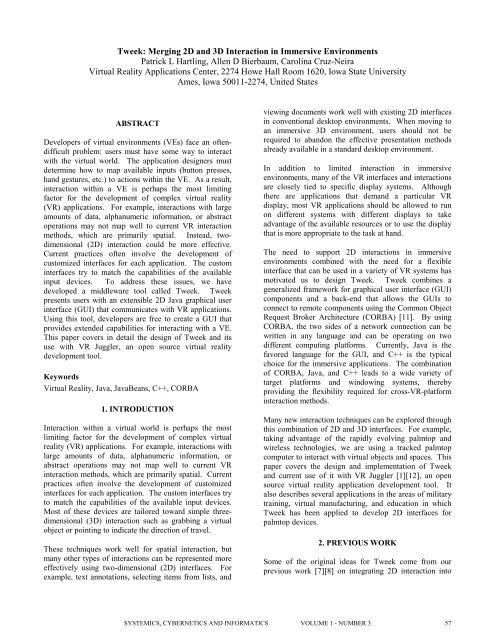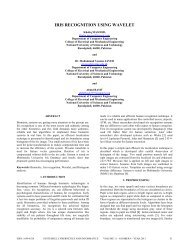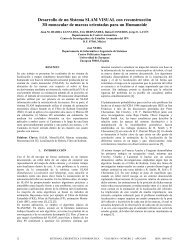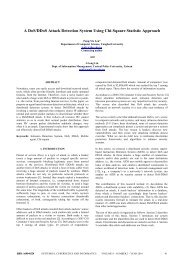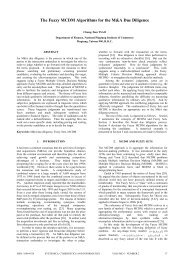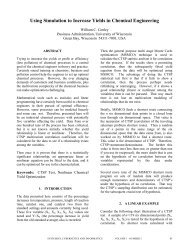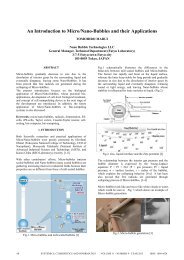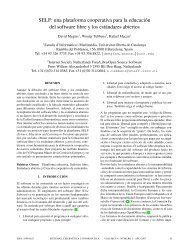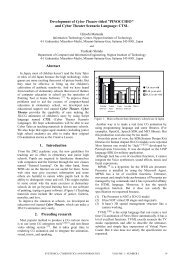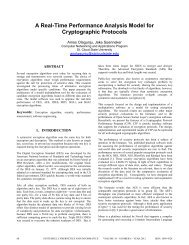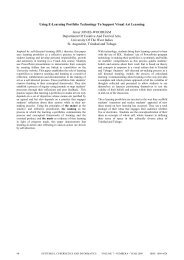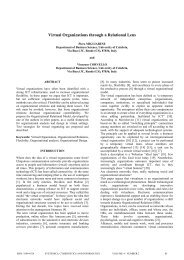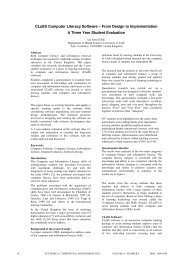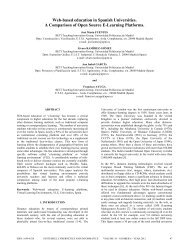Tweek: Merging 2D and 3D Interaction in Immersive Environments ...
Tweek: Merging 2D and 3D Interaction in Immersive Environments ...
Tweek: Merging 2D and 3D Interaction in Immersive Environments ...
You also want an ePaper? Increase the reach of your titles
YUMPU automatically turns print PDFs into web optimized ePapers that Google loves.
<strong>Tweek</strong>: <strong>Merg<strong>in</strong>g</strong> <strong>2D</strong> <strong>and</strong> <strong>3D</strong> <strong>Interaction</strong> <strong>in</strong> <strong>Immersive</strong> <strong>Environments</strong><br />
Patrick L Hartl<strong>in</strong>g, Allen D Bierbaum, Carol<strong>in</strong>a Cruz-Neira<br />
Virtual Reality Applications Center, 2274 Howe Hall Room 1620, Iowa State University<br />
Ames, Iowa 50011-2274, United States<br />
ABSTRACT<br />
Developers of virtual environments (VEs) face an oftendifficult<br />
problem: users must have some way to <strong>in</strong>teract<br />
with the virtual world. The application designers must<br />
determ<strong>in</strong>e how to map available <strong>in</strong>puts (button presses,<br />
h<strong>and</strong> gestures, etc.) to actions with<strong>in</strong> the VE. As a result,<br />
<strong>in</strong>teraction with<strong>in</strong> a VE is perhaps the most limit<strong>in</strong>g<br />
factor for the development of complex virtual reality<br />
(VR) applications. For example, <strong>in</strong>teractions with large<br />
amounts of data, alphanumeric <strong>in</strong>formation, or abstract<br />
operations may not map well to current VR <strong>in</strong>teraction<br />
methods, which are primarily spatial. Instead, twodimensional<br />
(<strong>2D</strong>) <strong>in</strong>teraction could be more effective.<br />
Current practices often <strong>in</strong>volve the development of<br />
customized <strong>in</strong>terfaces for each application. The custom<br />
<strong>in</strong>terfaces try to match the capabilities of the available<br />
<strong>in</strong>put devices. To address these issues, we have<br />
developed a middleware tool called <strong>Tweek</strong>. <strong>Tweek</strong><br />
presents users with an extensible <strong>2D</strong> Java graphical user<br />
<strong>in</strong>terface (GUI) that communicates with VR applications.<br />
Us<strong>in</strong>g this tool, developers are free to create a GUI that<br />
provides extended capabilities for <strong>in</strong>teract<strong>in</strong>g with a VE.<br />
This paper covers <strong>in</strong> detail the design of <strong>Tweek</strong> <strong>and</strong> its<br />
use with VR Juggler, an open source virtual reality<br />
development tool.<br />
Keywords<br />
Virtual Reality, Java, JavaBeans, C++, CORBA<br />
1. INTRODUCTION<br />
<strong>Interaction</strong> with<strong>in</strong> a virtual world is perhaps the most<br />
limit<strong>in</strong>g factor for the development of complex virtual<br />
reality (VR) applications. For example, <strong>in</strong>teractions with<br />
large amounts of data, alphanumeric <strong>in</strong>formation, or<br />
abstract operations may not map well to current VR<br />
<strong>in</strong>teraction methods, which are primarily spatial. Current<br />
practices often <strong>in</strong>volve the development of customized<br />
<strong>in</strong>terfaces for each application. The custom <strong>in</strong>terfaces try<br />
to match the capabilities of the available <strong>in</strong>put devices.<br />
Most of these devices are tailored toward simple threedimensional<br />
(<strong>3D</strong>) <strong>in</strong>teraction such as grabb<strong>in</strong>g a virtual<br />
object or po<strong>in</strong>t<strong>in</strong>g to <strong>in</strong>dicate the direction of travel.<br />
These techniques work well for spatial <strong>in</strong>teraction, but<br />
many other types of <strong>in</strong>teractions can be represented more<br />
effectively us<strong>in</strong>g two-dimensional (<strong>2D</strong>) <strong>in</strong>terfaces. For<br />
example, text annotations, select<strong>in</strong>g items from lists, <strong>and</strong><br />
view<strong>in</strong>g documents work well with exist<strong>in</strong>g <strong>2D</strong> <strong>in</strong>terfaces<br />
<strong>in</strong> conventional desktop environments. When mov<strong>in</strong>g to<br />
an immersive <strong>3D</strong> environment, users should not be<br />
required to ab<strong>and</strong>on the effective presentation methods<br />
already available <strong>in</strong> a st<strong>and</strong>ard desktop environment.<br />
In addition to limited <strong>in</strong>teraction <strong>in</strong> immersive<br />
environments, many of the VR <strong>in</strong>terfaces <strong>and</strong> <strong>in</strong>teractions<br />
are closely tied to specific display systems. Although<br />
there are applications that dem<strong>and</strong> a particular VR<br />
display, most VR applications should be allowed to run<br />
on different systems with different displays to take<br />
advantage of the available resources or to use the display<br />
that is more appropriate to the task at h<strong>and</strong>.<br />
The need to support <strong>2D</strong> <strong>in</strong>teractions <strong>in</strong> immersive<br />
environments comb<strong>in</strong>ed with the need for a flexible<br />
<strong>in</strong>terface that can be used <strong>in</strong> a variety of VR systems has<br />
motivated us to design <strong>Tweek</strong>. <strong>Tweek</strong> comb<strong>in</strong>es a<br />
generalized framework for graphical user <strong>in</strong>terface (GUI)<br />
components <strong>and</strong> a back-end that allows the GUIs to<br />
connect to remote components us<strong>in</strong>g the Common Object<br />
Request Broker Architecture (CORBA) [11]. By us<strong>in</strong>g<br />
CORBA, the two sides of a network connection can be<br />
written <strong>in</strong> any language <strong>and</strong> can be operat<strong>in</strong>g on two<br />
different comput<strong>in</strong>g platforms. Currently, Java is the<br />
favored language for the GUI, <strong>and</strong> C++ is the typical<br />
choice for the immersive applications. The comb<strong>in</strong>ation<br />
of CORBA, Java, <strong>and</strong> C++ leads to a wide variety of<br />
target platforms <strong>and</strong> w<strong>in</strong>dow<strong>in</strong>g systems, thereby<br />
provid<strong>in</strong>g the flexibility required for cross-VR-platform<br />
<strong>in</strong>teraction methods.<br />
Many new <strong>in</strong>teraction techniques can be explored through<br />
this comb<strong>in</strong>ation of <strong>2D</strong> <strong>and</strong> <strong>3D</strong> <strong>in</strong>terfaces. For example,<br />
tak<strong>in</strong>g advantage of the rapidly evolv<strong>in</strong>g palmtop <strong>and</strong><br />
wireless technologies, we are us<strong>in</strong>g a tracked palmtop<br />
computer to <strong>in</strong>teract with virtual objects <strong>and</strong> spaces. This<br />
paper covers the design <strong>and</strong> implementation of <strong>Tweek</strong><br />
<strong>and</strong> current use of it with VR Juggler [1][12], an open<br />
source virtual reality application development tool. It<br />
also describes several applications <strong>in</strong> the areas of military<br />
tra<strong>in</strong><strong>in</strong>g, virtual manufactur<strong>in</strong>g, <strong>and</strong> education <strong>in</strong> which<br />
<strong>Tweek</strong> has been applied to develop <strong>2D</strong> <strong>in</strong>terfaces for<br />
palmtop devices.<br />
2. PREVIOUS WORK<br />
Some of the orig<strong>in</strong>al ideas for <strong>Tweek</strong> come from our<br />
previous work [7][8] on <strong>in</strong>tegrat<strong>in</strong>g <strong>2D</strong> <strong>in</strong>teraction <strong>in</strong>to<br />
SYSTEMICS, CYBERNETICS AND INFORMATICS VOLUME 1 - NUMBER 3 57
immersive environments. This work used a Java-based<br />
GUI; however it lacked the CORBA components <strong>and</strong> a<br />
flexible design that could adapt to application needs.<br />
Other work <strong>in</strong> this area [4][6][9] has focused on the<br />
effectiveness of us<strong>in</strong>g a palmtop <strong>in</strong> virtual environments.<br />
These efforts put little emphasis on the design of a<br />
framework that will support user- or application-def<strong>in</strong>ed<br />
GUIs without requir<strong>in</strong>g customization of the underly<strong>in</strong>g<br />
<strong>in</strong>frastructure. With <strong>Tweek</strong>, we are build<strong>in</strong>g on these<br />
earlier works to provide the miss<strong>in</strong>g framework.<br />
3. TWEEK MOTIVATION<br />
In this section, we expla<strong>in</strong> the motivation beh<strong>in</strong>d <strong>Tweek</strong><br />
<strong>and</strong> its novel features, especially as they relate to<br />
previous work <strong>in</strong> the use of <strong>2D</strong> GUIs <strong>in</strong> <strong>3D</strong><br />
environments. We beg<strong>in</strong> with the flexibility <strong>in</strong> choos<strong>in</strong>g<br />
a programm<strong>in</strong>g language for implement<strong>in</strong>g applications<br />
<strong>and</strong> GUIs. We then expla<strong>in</strong> the importance of GUI<br />
portability <strong>and</strong> what <strong>Tweek</strong> offers <strong>in</strong> this area. F<strong>in</strong>ally,<br />
we discuss how the <strong>Tweek</strong> software reuses exist<strong>in</strong>g<br />
technology, especially that of GUI implementations.<br />
Programm<strong>in</strong>g Language Independence<br />
In the field of comput<strong>in</strong>g, the state of the art changes<br />
constantly, <strong>and</strong> programm<strong>in</strong>g languages are not exempt<br />
from these changes. While object-oriented programm<strong>in</strong>g<br />
is popular today, it may not always be the favored<br />
paradigm. Languages that implement paradigms change<br />
<strong>in</strong> popularity as well.<br />
As part of the development of <strong>Tweek</strong>, we have<br />
experimented with multi-language capabilities. The<br />
result is an implementation that allows any programm<strong>in</strong>g<br />
languages to be used for VR application development <strong>and</strong><br />
for GUI development. The current implementation<br />
focuses on Java for the GUI <strong>and</strong> C++ for the VR<br />
application, but this need not always be the case.<br />
Programm<strong>in</strong>g language <strong>in</strong>dependence <strong>in</strong> <strong>Tweek</strong> is<br />
realized through the use of CORBA. CORBA itself is a<br />
st<strong>and</strong>ardized cross-platform, language-<strong>in</strong>dependent tool<br />
for distributed programm<strong>in</strong>g. These characteristics make<br />
CORBA well suited for use with <strong>Tweek</strong> where the VR<br />
applications <strong>and</strong> the GUI are not necessarily written us<strong>in</strong>g<br />
the same programm<strong>in</strong>g language nor do they necessarily<br />
execute on the same computer.<br />
GUI Portability<br />
VR applications often must be capable of execut<strong>in</strong>g <strong>in</strong> a<br />
variety of configurations, from low-end PCs to<br />
expensive, high-end supercomputers. If a GUI will be<br />
used with a VR application, it should be capable of<br />
mov<strong>in</strong>g between systems with the application. Thus,<br />
GUI portability becomes an important issue. Some<br />
previous work <strong>in</strong> this area has allowed the GUI to run<br />
only <strong>in</strong> a s<strong>in</strong>gle comput<strong>in</strong>g environment [6]. With<br />
<strong>Tweek</strong>, we have aimed to address such limitations by<br />
mak<strong>in</strong>g the GUI portable from traditional desktop<br />
<strong>in</strong>teraction to fully immersive <strong>3D</strong> graphics.<br />
With a portable GUI, VR application developers can<br />
work with the same <strong>in</strong>terface <strong>in</strong> a variety of VR system<br />
configurations. For example, developers of VR<br />
applications often have the ability to develop their<br />
environments <strong>in</strong> what is known as “simulator mode”.<br />
Generally, this means us<strong>in</strong>g a desktop computer for<br />
application design <strong>and</strong> cod<strong>in</strong>g. When runn<strong>in</strong>g the<br />
application, the mouse <strong>and</strong> keyboard are used to represent<br />
the <strong>in</strong>put devices actually available <strong>in</strong> the full-scale VR<br />
system. Thus, the developer can simulate all the actions<br />
possible <strong>in</strong> the VR system us<strong>in</strong>g the desktop<br />
environment. With this underst<strong>and</strong><strong>in</strong>g of simulat<strong>in</strong>g a<br />
VR system on a desktop, we have the motivation for<br />
mak<strong>in</strong>g a GUI <strong>in</strong>put to the virtual world portable between<br />
the desktop <strong>and</strong> the VR system.<br />
Mov<strong>in</strong>g beyond the desktop simulation, the <strong>Tweek</strong> GUI<br />
can be brought <strong>in</strong>to CAVE-like VR systems where<br />
large projection screens are used for display<strong>in</strong>g the <strong>3D</strong><br />
graphics [2]. To br<strong>in</strong>g the GUI <strong>in</strong>to the VR system, users<br />
may <strong>in</strong>stall the <strong>Tweek</strong> GUI software on a palmtop<br />
computer or on a personal digital assistant (PDA).<br />
Current wireless technology makes the use of such<br />
comput<strong>in</strong>g devices <strong>in</strong> CAVE-like systems convenient<br />
<strong>and</strong> easy.<br />
When a palmtop computer is not available, the <strong>Tweek</strong><br />
GUI can make use of <strong>3D</strong> w<strong>in</strong>dow<strong>in</strong>g tools to run as a <strong>2D</strong><br />
representation <strong>in</strong> an immersive <strong>3D</strong> environment. This is<br />
because the <strong>in</strong>terface between the user <strong>and</strong> the virtual<br />
environment is separated physically from the virtual<br />
reality system <strong>and</strong> is therefore made portable. This<br />
preserves the user’s sense of presence because the<br />
<strong>in</strong>terface rema<strong>in</strong>s with the user's person as part of the<br />
accessible environment, <strong>in</strong>dependent of the VR system<br />
used.<br />
Reuse of Exist<strong>in</strong>g GUI Technology<br />
Current <strong>2D</strong> GUI technology is very mature <strong>and</strong> very well<br />
understood. Based on previous efforts to <strong>in</strong>corporate <strong>2D</strong><br />
<strong>in</strong>teraction <strong>in</strong>to immersive <strong>3D</strong> spaces, we have found that<br />
some <strong>in</strong>teractions are better suited to <strong>2D</strong> GUIs than to <strong>3D</strong><br />
GUIs or <strong>3D</strong> spatial <strong>in</strong>teraction [8]. Thus, the desire to<br />
reuse <strong>2D</strong> GUI technology has played a major role <strong>in</strong><br />
design<strong>in</strong>g the <strong>Tweek</strong> software.<br />
The current <strong>Tweek</strong> implementation makes use of exist<strong>in</strong>g<br />
Java-based GUI software libraries. More specifically, we<br />
use the popular Java Sw<strong>in</strong>g libraries that have been<br />
<strong>in</strong>cluded with all Java Development Kit releases s<strong>in</strong>ce<br />
Version 1.2. As long as a Java virtual mach<strong>in</strong>e (JVM)<br />
<strong>and</strong> a w<strong>in</strong>dow<strong>in</strong>g system are available, the <strong>Tweek</strong> GUI<br />
software can be executed. The use of Java does impose<br />
some restrictions, however, due to JVM availability <strong>and</strong><br />
58<br />
SYSTEMICS, CYBERNETICS AND INFORMATICS VOLUME 1 - NUMBER 3
Figure 1 Stuff <strong>in</strong> VR<br />
Figure 1 Palmtop <strong>in</strong> an immersive environment<br />
JVM memory use. For example, most current PDAs<br />
have limited memory (both volatile <strong>and</strong> persistent) <strong>and</strong><br />
may not have a full Java runtime implementation yet. We<br />
feel that the rapidly improv<strong>in</strong>g state of PDA technology<br />
will lessen the complications imposed by these<br />
drawbacks.<br />
By reus<strong>in</strong>g exist<strong>in</strong>g Java GUI technology, we have been<br />
able to focus on the <strong>in</strong>teraction methods rather than on<br />
the implementation of our own GUI software. The<br />
language-<strong>in</strong>dependence feature of <strong>Tweek</strong> offers the<br />
potential for us<strong>in</strong>g other popular cross-platform GUI<br />
toolkits such as Qt <strong>and</strong> GTK+ as well as the use of other<br />
operat<strong>in</strong>g system-native toolkits.<br />
4. TWEEK DESIGN<br />
The basic design goal of <strong>Tweek</strong> is to provide a crossplatform,<br />
cross-language framework with<strong>in</strong> which VR<br />
application programmers can implement <strong>2D</strong> GUI<br />
<strong>in</strong>teractions with a <strong>3D</strong> environment. To achieve this, the<br />
Observer design pattern [3] is implemented such that the<br />
subject is the VR application <strong>and</strong> the observer is the GUI.<br />
Thus, graphical components with<strong>in</strong> the GUI control act as<br />
viewers of state <strong>in</strong>formation ma<strong>in</strong>ta<strong>in</strong>ed by the VR<br />
application. The state <strong>in</strong>formation is entirely user<br />
def<strong>in</strong>ed. It may, for example, conta<strong>in</strong> the user’s position<br />
<strong>and</strong> orientation so that a top-down map can be displayed<br />
<strong>in</strong> the GUI as a navigation aid.<br />
With this basic foundation, users <strong>in</strong> a virtual environment<br />
(VE) can manipulate the <strong>2D</strong> <strong>in</strong>teraction on a palmtop<br />
computer <strong>in</strong> exactly the same manner as they manipulate<br />
conventional <strong>2D</strong> <strong>in</strong>terfaces <strong>in</strong> a desktop environment.<br />
The palmtop provides a physical <strong>in</strong>terface for display<strong>in</strong>g<br />
<strong>and</strong> us<strong>in</strong>g the GUI. It can be <strong>in</strong>tegrated <strong>in</strong>to the virtual<br />
world simply by br<strong>in</strong>g<strong>in</strong>g the palmtop computer <strong>in</strong>to the<br />
space, as can be seen <strong>in</strong> Figure 1. Input to the GUI is<br />
transmitted via a network connection to the immersive<br />
<strong>3D</strong> application, <strong>and</strong> the application responds accord<strong>in</strong>gly.<br />
In the same manner, the application can communicate<br />
<strong>in</strong>formation back to the user through the GUI. This<br />
enables users, for <strong>in</strong>stance, to add more <strong>in</strong>formation about<br />
virtual objects; to see specifications of a recently selected<br />
object; or to make text annotations about objects us<strong>in</strong>g<br />
the palmtop <strong>in</strong>put device. By simplify<strong>in</strong>g data <strong>in</strong>put with<br />
the <strong>2D</strong> device, users can also provide f<strong>in</strong>e-gra<strong>in</strong>ed<br />
specification of numerical values. Object selection <strong>and</strong><br />
world navigation can be simplified by provid<strong>in</strong>g a <strong>2D</strong><br />
overview of the environment.<br />
The <strong>Tweek</strong> software is not limited to display of elements<br />
for direct application <strong>in</strong>teraction. Its GUI can load any<br />
other GUI component that is needed. For example, a web<br />
browser could be run for show<strong>in</strong>g maps or documentation<br />
about the immersive world. A scientific visualization<br />
application could <strong>in</strong>corporate a st<strong>and</strong>ard database frontend<br />
<strong>in</strong>to <strong>Tweek</strong> so that database manipulations could be<br />
visualized <strong>in</strong>stantly.<br />
5. TWEEK IMPLEMENTATION<br />
<strong>Tweek</strong> is a collection of multiple technologies: C++,<br />
Java, JavaBeans, the Extensible Markup Language<br />
(XML), <strong>and</strong> CORBA. Comb<strong>in</strong>ed, these allow a Java GUI<br />
composed of plug-<strong>in</strong>s to communicate with a C++<br />
application. We expla<strong>in</strong> the use of these technologies <strong>in</strong><br />
this section.<br />
Java GUI <strong>and</strong> JavaBeans<br />
In order to offer users a highly flexible GUI, <strong>Tweek</strong><br />
<strong>in</strong>cludes a generic Java-based application framework that<br />
loads plug-<strong>in</strong>s dynamically to extend its functionality.<br />
These plug-<strong>in</strong>s may be discovered when the <strong>Tweek</strong> Java<br />
GUI is <strong>in</strong>itialized; they may be loaded from disk after the<br />
GUI has already been activated; or they may be<br />
downloaded, or “pushed”, from the immersive <strong>3D</strong><br />
application. The last of these options allows the <strong>3D</strong><br />
environment developers to bundle a custom GUI with<br />
their application. A user’s palmtop can then receive the<br />
GUI plug-<strong>in</strong> automatically when first stepp<strong>in</strong>g <strong>in</strong>to the<br />
VR system.<br />
The plug-<strong>in</strong>s loaded by the Java GUI are implemented as<br />
JavaBeans (Beans) [5]. The Beans fall <strong>in</strong>to one of four<br />
categories:<br />
1. Service Beans<br />
2. Viewer Beans<br />
3. Panel Beans<br />
4. Generic Beans<br />
SYSTEMICS, CYBERNETICS AND INFORMATICS VOLUME 1 - NUMBER 3 59
Service Beans encapsulate functionality that may be<br />
useful to core elements of the <strong>Tweek</strong> Java GUI or to<br />
dynamically loaded code. The entire <strong>in</strong>terface for a<br />
Service Bean must be known when the code us<strong>in</strong>g the<br />
service is compiled. This is necessary because the us<strong>in</strong>g<br />
code needs to be able to take full advantage of the<br />
service.<br />
Viewer Beans provide a visualization <strong>and</strong> organization of<br />
the loaded graphical Beans. All Viewer Beans must<br />
implement a well-known Java <strong>in</strong>terface def<strong>in</strong>ed as part of<br />
the basic <strong>Tweek</strong> Java application programmer <strong>in</strong>terface<br />
(API). These Beans may be changed at runtime to<br />
present users with different views of the same set of<br />
graphical Beans. Users of the <strong>Tweek</strong> Java GUI can write<br />
their own Viewer Bean to get a custom view that suits<br />
their needs <strong>and</strong> preferences.<br />
Panel Beans are the key to extension of the <strong>Tweek</strong> Java<br />
GUI. These Beans add components to the generic GUI<br />
<strong>and</strong> thus provide extended functionality. Programmers<br />
design<strong>in</strong>g a custom GUI to their VR applications write<br />
Panel Beans that make use of exist<strong>in</strong>g Java GUI<br />
components. All Panel Beans must have a “key” class<br />
that derives from the basic Java Sw<strong>in</strong>g class<br />
javax.sw<strong>in</strong>g.Jcomponent (or some subclass<br />
thereof). This is required so that the key class may be<br />
<strong>in</strong>stantiated <strong>and</strong> added to the GUI layout. Optionally,<br />
Panel Bean authors may implement other <strong>in</strong>terfaces<br />
def<strong>in</strong>ed as part of the basic <strong>Tweek</strong> GUI API to extend the<br />
capabilities of their Beans.<br />
The last category <strong>in</strong>to which a Bean may be classified is<br />
the Generic Bean. Noth<strong>in</strong>g is assumed about Generic<br />
Beans. This Bean category is provided so that other<br />
Beans can do their own dynamic code load<strong>in</strong>g. For<br />
example, a Bean that uses a Factory pattern [3] may want<br />
to have the “workers” loaded dynamically based on some<br />
criteria. In so do<strong>in</strong>g, the functionality of the factory can<br />
be changed dynamically.<br />
XML Descriptions<br />
Beans are discovered us<strong>in</strong>g XML-based descriptions.<br />
The XML description provides all necessary <strong>in</strong>formation<br />
<strong>in</strong>clud<strong>in</strong>g paths <strong>and</strong> external dependencies. An example<br />
XML file is shown <strong>in</strong> Figure 2. This gives an example of<br />
a Panel Bean conta<strong>in</strong>ed <strong>in</strong> the Java archive<br />
PfControlBean.jar. With<strong>in</strong> the archive, there is an<br />
entry vrjtest/PfControl that is the aforementioned<br />
“key” class for the Panel Bean. This class will be<br />
<strong>in</strong>stantiated by the <strong>Tweek</strong> Java GUI <strong>and</strong> added to the GUI<br />
layout.<br />
Observer Pattern<br />
Earlier, we stated that <strong>Tweek</strong> uses the Observer design<br />
pattern [3]. This pattern def<strong>in</strong>es a separation between the<br />
state of an object <strong>and</strong> a view of that state. With<strong>in</strong> the<br />
<br />
<br />
<br />
<br />
<br />
<br />
<br />
Figure 2 Sample XML Bean description<br />
pattern, there are two classes: observer <strong>and</strong> subject. The<br />
subject ma<strong>in</strong>ta<strong>in</strong>s the state; the observer provides a view<br />
of the state. A s<strong>in</strong>gle subject may have multiple<br />
observers, each of which is notified when the state of the<br />
subject changes. When notified of changes, observers<br />
query their subjects to get the latest state <strong>in</strong>formation.<br />
In <strong>Tweek</strong>, the use of the Observer pattern is implemented<br />
with CORBA. CORBA provides the l<strong>in</strong>k between the<br />
Java GUI <strong>and</strong> the VR applications. When work<strong>in</strong>g with<br />
CORBA, all objects are accessed us<strong>in</strong>g references. The<br />
reference has a well-known <strong>in</strong>terface that can be accessed<br />
by any programm<strong>in</strong>g language. A language-<strong>in</strong>dependent<br />
<strong>in</strong>terface to an object is specified us<strong>in</strong>g the Interface<br />
Def<strong>in</strong>ition Language (IDL). IDL is not a programm<strong>in</strong>g<br />
language, but it <strong>in</strong>cludes the basic concepts of types, both<br />
fundamental <strong>and</strong> aggregate, <strong>and</strong> functions.<br />
Implementations of the <strong>in</strong>terfaces must be written <strong>in</strong> a<br />
programm<strong>in</strong>g language such as C++, Java, or Perl.<br />
To simplify the def<strong>in</strong>ition of <strong>in</strong>terfaces, <strong>Tweek</strong> def<strong>in</strong>es<br />
two basic <strong>in</strong>terfaces: tweek::Subject <strong>and</strong><br />
tweek::Observer. The programmers of VR<br />
applications <strong>and</strong> GUI extend these <strong>in</strong>terfaces to def<strong>in</strong>e<br />
behavior specific to their applications. Extensions to the<br />
subject <strong>in</strong>terface will be used by the VR application to<br />
manage state <strong>in</strong>formation. Extensions to the observer<br />
<strong>in</strong>terface will be used by the Java GUI to visualize <strong>and</strong><br />
possibly manipulate the state <strong>in</strong>formation. Each subject<br />
implementation must have a correspond<strong>in</strong>g observer<br />
implementation.<br />
To simplify object access further, a third <strong>in</strong>terface,<br />
tweek::SubjectManager, is def<strong>in</strong>ed. An object<br />
called the Subject Manager may be created on every node<br />
where subjects will be <strong>in</strong>stantiated. Application-specific<br />
subjects are registered with the Subject Manager, <strong>and</strong><br />
nodes that need a reference to a given subject request the<br />
reference through the Subject Manager. References are<br />
requested us<strong>in</strong>g unique, symbolic str<strong>in</strong>gs. Thus, the job<br />
of the Subject Manager is to hide the details of object<br />
registration <strong>and</strong> reference request<strong>in</strong>g.<br />
6. CURRENT USES OF TWEEK<br />
<strong>Tweek</strong> is <strong>in</strong> use at the Virtual Reality Applications Center<br />
at Iowa State University. We use the <strong>Tweek</strong> Java GUI on<br />
palmtop computers to control applications <strong>in</strong> our<br />
projection-based VR systems. For example, we use<br />
60<br />
SYSTEMICS, CYBERNETICS AND INFORMATICS VOLUME 1 - NUMBER 3
<strong>Tweek</strong> on a palmtop to provide extended <strong>in</strong>put<br />
capabilities for a military tra<strong>in</strong><strong>in</strong>g application. It <strong>in</strong>cludes<br />
VCR-like controls that allow playback of recorded<br />
tra<strong>in</strong><strong>in</strong>g data; six-degree-of-freedom navigation<br />
capabilities; detailed entity data readout for <strong>in</strong>dividual<br />
military units; <strong>and</strong> visual options for the units <strong>and</strong> the<br />
environment.<br />
This application is written us<strong>in</strong>g VR Juggler, an open<br />
source, cross-platform framework for the development of<br />
VR applications [1]. VR Juggler provides a “virtual<br />
platform” that abstracts the details of the VR hardware<br />
system. It thus allows the applications to be more<br />
portable. When us<strong>in</strong>g <strong>Tweek</strong> with VR Juggler, the GUI<br />
<strong>in</strong>terfaces become portable as well.<br />
7. CONCLUSIONS AND FUTURE WORK<br />
The next stage of development for <strong>Tweek</strong> will <strong>in</strong>clude<br />
dynamic <strong>in</strong>stallation of GUI panels on the palmtop<br />
computer. The goal is to allow any user to enter the VE<br />
<strong>and</strong> get the GUI panels automatically. This functionality<br />
will be realized by tak<strong>in</strong>g advantage of GUI component<br />
“push<strong>in</strong>g”, as discussed earlier.<br />
We are <strong>in</strong>terested <strong>in</strong> the extension of <strong>Tweek</strong> GUIs <strong>in</strong>to<br />
the realm of Java applets, small programs that may be<br />
loaded by common World Wide Web browsers. We feel<br />
that <strong>in</strong>corporation <strong>in</strong>to the well-known browser <strong>in</strong>terface<br />
could enhance the usability of the <strong>2D</strong> GUI, especially for<br />
<strong>in</strong>experienced users. Related to this, we will <strong>in</strong>vestigate<br />
encryption <strong>and</strong> authentication capabilities available with<br />
various CORBA implementations to enable secure<br />
communication only with authorized parties.<br />
[5] G. Hamilton (ed.), JavaBeans 1.01 Specification,<br />
Sun Microsystems, Mounta<strong>in</strong> View, CA, 1997.<br />
[6] K. Watsen, R.P. Darken, M.V. Capps, “A H<strong>and</strong>held<br />
Computer as an <strong>Interaction</strong> Device to a Virtual<br />
Environment”, 3 rd International <strong>Immersive</strong><br />
Projection Technology Workshop (IPT 1999),<br />
Stuttgart, Germany, May 10−11, 1999.<br />
[7] L.C. Hill, C. Cruz-Neira. “Palmtop <strong>Interaction</strong><br />
Methods for the <strong>Immersive</strong> Projection Technology<br />
VR Systems”, 4 th International Workshop on<br />
<strong>Immersive</strong> Projection Technology (IPT 2000), Ames,<br />
Iowa, June 19−20, 2000.<br />
[8] L.C. Hill, Usability of <strong>2D</strong> Palmtop <strong>Interaction</strong><br />
Device <strong>in</strong> <strong>Immersive</strong> Virtual <strong>Environments</strong>, Master’s<br />
thesis, Iowa State University, 2000.<br />
[9] M.M. Wloka, E. Greenfield, “The Virtual Tricorder:<br />
A Uniform Interface to Virtual Reality”, UIST'95<br />
Proceed<strong>in</strong>gs, 1995.<br />
[10] N. Elmqvist, <strong>3D</strong>wm: Three-Dimensional User<br />
Interfaces Us<strong>in</strong>g Fast Constructive Solid Geometry,<br />
Master’s thesis, Chalmers University of Technology,<br />
Göteborg, Sweden, 2001.<br />
[11] OMG, The Common Object Request Broker:<br />
Architecture <strong>and</strong> Specification, 2.6 ed., Object<br />
Management Group, December 2001.<br />
[12] VR Juggler WWW site, http://www.vrjuggler.org/,<br />
current April 10, 2002<br />
We plan to make use of <strong>Tweek</strong> GUIs mapped directly<br />
<strong>in</strong>to the <strong>3D</strong> environment. We plan to experiment with<br />
exist<strong>in</strong>g work such as <strong>3D</strong>wm [10]. Our goal is to offer an<br />
immersive GUI with familiar controls without re<strong>in</strong>vent<strong>in</strong>g<br />
GUI technology.<br />
8. REFERENCES<br />
[1] A. Bierbaum, VR Juggler: A Virtual Platform for<br />
Virtual Reality Application Development, Master’s<br />
thesis, Iowa State University, 2000.<br />
[2] C. Cruz-Neira, Virtual Reality Based on Multiple<br />
Projection Screens: The CAVE <strong>and</strong> Its Applications<br />
to Computational Science <strong>and</strong> Eng<strong>in</strong>eer<strong>in</strong>g, Ph. D.<br />
dissertation, University of Ill<strong>in</strong>ois at Chicago, 1995.<br />
[3] E. Gamma, et. al., Design Patterns: Elements of<br />
Reusable Object-Oriented Software, Addison-<br />
Wesley Professional Comput<strong>in</strong>g Series, Addison-<br />
Wesley Publish<strong>in</strong>g Company, New York, NY, 1995.<br />
[4] G.W. Fitzmaurice, W. Buxton, “The Chameleon:<br />
Spatially Aware Palmtop Computers”, ACM CHI'94,<br />
pp 451−452, 1994.<br />
SYSTEMICS, CYBERNETICS AND INFORMATICS VOLUME 1 - NUMBER 3 61


